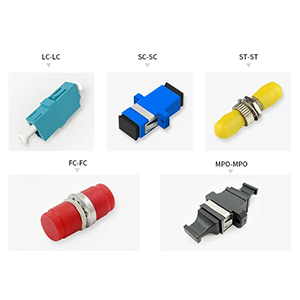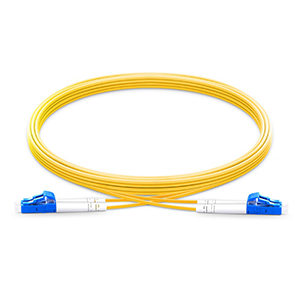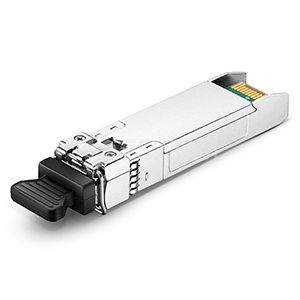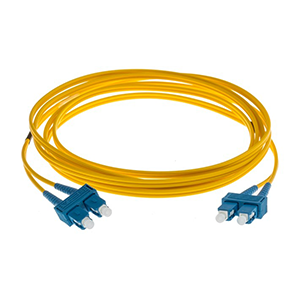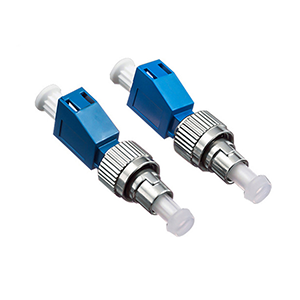Hello everyone! Today I am happy to give you a comprehensive introduction to the core components of fiber optic networks – what are the types of fiber optics. As the key foundation for realizing high-speed and high-bandwidth transmission, different types of optical fibers play an important role in network applications. In this article, I will deeply discuss the basic principles and classification standards of optical fiber, introduce the technical characteristics of common optical fiber types in detail, and analyze for you how to choose the appropriate optical fiber type according to actual needs. I believe this will help you build an efficient and reliable fiber optic network infrastructure.
Overview of the working principle and classification of optical fibers
Through the following detailed introduction, you can choose the appropriate fiber type according to different application needs to meet the requirements for transmission performance, distance and bandwidth.
Transmission principle of optical fiber
- The optical fiber is composed of a two-layer structure: a high refractive index core layer and a low refractive index cladding layer.
- When light propagates in the core layer with high refractive index, it undergoes total reflection with the cladding layer, and is thus restricted in transmission inside the core layer.
- This mechanism that uses the principle of total reflection to guide and transmit optical signals enables optical fibers to transmit tens or even hundreds of kilometers with extremely low loss.
- Compared with traditional copper cables, optical fiber has the advantages of higher bandwidth, lower loss, and immunity to electromagnetic interference.
Main classification standards for optical fibers
- Mode division: single-mode fiber vs. multi-mode fiber
- The core diameter of single-mode fiber is small (8-10μm), allowing only one propagation mode, long transmission distance and large bandwidth
- Multimode optical fiber has a larger core diameter (50-100μm), allowing multiple propagation modes, shorter transmission distance, and limited bandwidth
- Material classification: quartz glass optical fiber vs. plastic optical fiber
- Quartz glass optical fiber has excellent performance and is used in trunk lines and backbone networks
- Plastic optical fiber is simple and low-cost to manufacture and suitable for short-range applications
- Structural division: fiber optic cable vs. bare fiber
- The optical fiber cable has an outer sheath and is suitable for outdoor pipeline laying
- Bare optical fiber has no outer protective layer and is used for indoor wiring or inside cabinets
Characteristics of optical fibers under different categories
- Single-mode 9/125μm: the most common single-mode optical fiber, used for long-distance trunk transmission
- Multi-mode 50/125μm, 62.5/125μm: commonly used in short-distance networks such as LANs and buildings
- Plastic optical fiber: good flexibility, easy to install, suitable for home, automobile and other applications
- Optical fiber cable: has good mechanical and environmental adaptability, suitable for outdoor pipeline laying
- Bare optical fiber: used in centralized wiring environments such as computer rooms and data centers
In general, different types of optical fibers have their own characteristics in terms of transmission performance and applicable scenarios, and they need to be selected according to specific application requirements. Only by fully mastering the basic classification knowledge of optical fibers can we better design and deploy optical fiber communication networks.
What are the common fiber types
I will introduce to you in detail the technical characteristics of common single-mode optical fibers and multi-mode optical fibers and their application advantages and disadvantages. You can choose the appropriate optical fiber type based on actual application needs and budget considerations.

Single-Mode Fiber, SMF
- The core diameter of optical fiber is small, usually 8-10μm, and only supports one light propagation mode.
- The transmission distance is long and is often used in trunk backbone networks, up to more than 100km.
- The bandwidth is extremely large and can support ultra-high-speed transmission up to Tbit/s level.
- The optical loss is low, usually in the range of 0.2-0.3dB/km.
- The manufacturing process requires high requirements and the cost is relatively high.
- The coupling efficiency is low and requires a precise light source coupling device.
- Application scenarios: backbone network, long-distance transmission, metropolitan area network, etc.
Multi-Mode Fiber, MMF
- The core diameter of optical fiber is large, usually 50-100μm, and supports multiple propagation modes.
- The transmission distance is short, generally within the range of 2-5km.
- Bandwidth is limited, usually at the 1-10Gbit/s level.
- The optical loss is relatively high, generally 0.5-3dB/km.
- The manufacturing process is relatively simple and the cost is low.
- The coupling efficiency is high and can be directly connected to low-cost light sources such as LEDs.
- Application scenarios: short-range networks such as local area networks, building wiring, and data centers.
Comparison of characteristics between single-mode optical fiber and multi-mode optical fiber
- Single-mode optical fiber has excellent performance and is suitable for trunk lines and long-distance transmission, but the cost is high.
- Multimode optical fiber has lower cost and is suitable for short-distance networks, but its performance is relatively poor.
- When selecting fiber type, factors such as transmission distance, bandwidth, cost, etc. need to be comprehensively considered and matched with actual application requirements.
For example, in metropolitan area network trunk lines, low-loss, high-bandwidth single-mode optical fiber is more suitable; while in short-distance networks such as buildings and data centers, lower-cost multi-mode optical fiber can meet the needs. Therefore, accurately grasping the characteristics of different optical fiber types is the key to designing and deploying high-performance optical fiber networks.
What fields can different fiber types be used in?
I will introduce to you in detail the applicability of different optical fiber types in various network application scenarios. The selection of optical fiber types is crucial to the application of network scenarios. Different types of optical fibers are suitable for different transmission distances, bandwidth requirements and cost budgets. .
In which fields are single-mode optical fibers used?
- The core characteristics of single-mode optical fiber are long transmission distance, large bandwidth and low loss.
- Therefore, they are very suitable for long-distance, high-capacity transmission application scenarios such as trunk backbone networks and metropolitan area networks.
- Single-mode optical fiber can provide a transmission distance of more than 100km, meeting the needs of trunk transmission. At the same time, its Tbit/s-level bandwidth supports high-speed transmission of trunk networks.
- The low-loss characteristics of single-mode fiber also ensure the stability and reliability of the trunk network and reduce the need for relay amplifiers.
- In addition, the cost of single-mode optical fiber is relatively high and is more suitable for the construction of trunk networks with large investments.
In which fields are multimode optical fibers used?
- Multimode optical fiber is characterized by short transmission distance and limited bandwidth, but low cost.
- They are more suitable for use in close-range network scenarios such as local area networks, building wiring, and data centers.
- Multi-mode optical fiber can usually provide a transmission distance of 2-5km to meet the connection needs of these short-distance networks.
- Although its bandwidth is more limited than single-mode, it is sufficient for most LAN applications.
- The cost advantage of multimode optical fiber makes it a better choice for short-distance networks, such as FTTH, building networks, etc.
How to choose the appropriate fiber type
- Selecting the appropriate fiber type is critical to the overall performance and cost of the network.
- If multi-mode optical fiber with poor performance is used in the trunk network, the transmission capacity and quality will inevitably be limited.
- On the contrary, using expensive single-mode optical fiber in short-distance networks will also cause unnecessary waste of investment.
- Therefore, selecting the appropriate fiber type according to specific network application scenarios and needs is the key to ensuring efficient network operation.
- Only by fully considering the match between the technical characteristics of optical fiber and network applications can we design an optical fiber network with excellent performance and reasonable investment.
So, single-mode fiber is suitable for long-distance trunk networks, while multi-mode fiber is more suitable for short-distance LAN applications. Choosing the right fiber type is a prerequisite for maximizing the performance of your fiber optic network. Only by deeply understanding the characteristics of different fiber types can we make wise choices and ensure the technical and economic benefits of network construction.
Key factors in fiber type selection
I will give you a detailed introduction to several key factors that should be considered when choosing the type of optical fiber to purchase, and provide the corresponding decision-making framework and suggestions for your reference.
The main factors to consider when choosing fiber type
- Transmission distance requirements
- Single-mode fiber is suitable for long-distance transmission, and multi-mode fiber is suitable for short-distance transmission
- Determine the required transmission distance based on the network topology and cabling plan
- Bandwidth requirements
- Single-mode optical fiber has ultra-large bandwidth and is suitable for high-speed transmission applications
- Multimode optical fiber has limited bandwidth and is suitable for medium and low speed applications
- Assess current and future bandwidth needs
- Cost Budget
- The cost of single-mode fiber is relatively high, while the cost of multi-mode fiber is relatively low
- Make fiber selection based on actual application scenarios and investment budget
- Installation environment
- Indoor environments can choose multi-mode optical fiber with better flexibility
- For outdoor pipeline laying, it is more suitable to use strong and durable single-mode optical fiber cables
- Existing device compatibility
- Make sure the fiber type you choose is compatible with existing equipment (such as transceivers)
Decision-making framework for selecting fiber type
- First determine the network application scenario, such as trunk network, LAN, FTTH, etc.
- According to the transmission distance and bandwidth requirements of the application scenario, initially determine single-mode or multi-mode optical fiber
- Compare the applicability of the two optical fibers based on factors such as investment budget and installation environment
- Consider all factors and select the optimal fiber type
There are following suggestions for selecting fiber type
- For long-distance high-speed transmission applications such as backbone networks and metropolitan area networks, single-mode optical fiber is preferred
- For short-distance, medium- and low-speed applications such as local area networks and building wiring, priority is given to lower-cost multimode optical fiber
- For user-side access networks such as FTTH, you can choose multi-mode optical fiber with better flexibility
- During the selection process, the compatibility of existing equipment should be taken into consideration, and the unification of optical fiber and equipment should be achieved as much as possible
- Based on the specific needs of the application scenario, make a final decision after comprehensively evaluating various factors
In short, choosing the appropriate fiber type requires comprehensive consideration of network application requirements, investment costs, installation environment and many other factors. It must not only meet current needs, but also consider future network development. Only by making the correct choice of optical fiber type can we ensure the construction of a high-performance, affordable optical fiber network.
Summary
Choosing the right fiber type is undoubtedly the key to fiber optic network construction. Different types of optical fibers have their own characteristics in terms of transmission distance, bandwidth, cost, etc., and they need to be appropriately selected according to specific application scenarios. Whether it is a metropolitan area network, a data center or an access network, choosing the appropriate fiber type can ensure the stable operation and reliability of the network.
We provide various types and specifications of optical fiber products, and are equipped with a professional technical team to provide you with consultation and guidance at any time. If you have any questions about choosing fiber type, please feel free to contact us for communication. Let us work together to build high-speed, efficient fiber optic network infrastructure to help your digital transformation!
Fiber Optic Types FAQ
The primary types of fiber optic cables are single-mode fiber (SMF) and multimode fiber (MMF). These two types differ in their core diameter, light propagation characteristics, and applications.
Single-mode fiber has a smaller core diameter (8-10 microns) and supports a single mode of light propagation, allowing for longer transmission distances and higher bandwidth. Multimode fiber has a larger core (50-100 microns) and supports multiple modes of light, suitable for shorter-distance applications.
Single-mode fiber is widely used in long-distance telecommunications, internet backbone networks, and high-bandwidth applications. Multimode fiber is commonly used in local area networks (LANs), building wiring, and shorter-distance connections.
In addition to single-mode and multimode, there are other specialized fiber optic cable types, such as polarization-maintaining (PM) fiber, dispersion-shifted fiber, and photonic crystal fiber, each designed for specific applications.
Key performance characteristics that differ include attenuation, bandwidth, dispersion, and numerical aperture. These factors impact the maximum transmission distance, data rate, and suitability for different applications.
Fiber optic cables can be configured as simplex (single fiber), duplex (two fibers), or multi-fiber cables, with different connector types and jacket materials depending on the application.
Single-mode fibers are typically identified by a yellow jacket color, while multimode fibers are often identified by an orange jacket color. The fiber type may also be indicated on the cable.
No, single-mode and multimode fibers are not interchangeable due to their fundamental differences in light propagation and performance characteristics. Attempting to use them interchangeably can result in signal degradation or communication failures.
Key factors include the required transmission distance, data rate, available equipment and light sources, and overall system design considerations, as single-mode and multimode fibers have different performance and cost implications.
Yes, there are ongoing developments in fiber optic technology, such as hollow-core fibers, few-mode fibers, and multicore fibers, which aim to address specific challenges or enable new applications.

